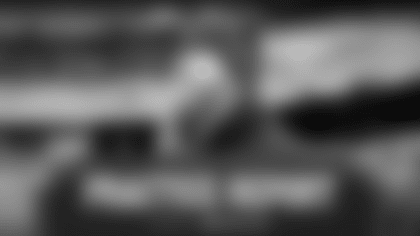In this latest Fitness Corner, Johnny Parker and Duane Carlisle review an important part of the 49ers pregame routine - stretching. Find out their approach, as well as some key areas of concern for some of the players.
Every Sunday, the 49ers strap on their pads, lace up their cleats, add some streaks of eye black and prepare to go to war. By the time a player reaches the NFL, this process has become so ingrained in them that it has become routine. Strength and Conditioning coaches Duane Carlisle and Johnny Parker play a large role in this routine, making sure players are stretched and physically prepared come kickoff.

"Typically, everybody has their own thing they like to do to get ready for the game," said Carlisle. "My role is to help support guys in getting ready for the game. For example, Frank Gore and I work together before every game and I take him through an extensive stretch and active/dynamic warm-up. Then we go through various movement drills that excite the nervous system, that start his engine so to speak. Then we go through some various additional movement drills such as sprint type drills, change of direction type drills with the ball just to get his muscles ready to play the game."
Carlisle has noticed a pattern in the ways certain players prepare for games. Some of the guys can be incredibly meticulous in the attention they pay to detail in their warm-ups.
"I would imagine that, at this level, guys know what they need to do to get ready for a game," said Carlisle. "I have observed time and time again, guys doing the same thing and the same type of warm-up. Whether this is superstition or not, I'm not sure, but it sure looks like it."
In addition to helping each player individually, Carlisle and Parker are also responsible for leading a team stretch prior to the game. The stretch usually starts one hour prior to kickoff and lasts for roughly 10 minutes.
"Mind you, it's a group environment," noted Carlisle. "Therefore, the stretch is designed to hit all the major muscle groups. The way we do that is to use AIS stretches (which stands for Active Isolated Stretches) which are basically a stretch and hold. You stretch the muscle for a two-count and then you relax. Then you stretch the muscle again, count to two and relax. In addition to that, we combine static stretches and dynamic stretches which are more ballistic stretches. Again, the goal here is to address all the major muscles groups as well as some of the small intrinsic muscles so that the guys get a real good stretch prior to going to the period with their position coaches."
Carlisle defines static stretches as a player holding a position for 20-30 seconds and dynamic stretches as stretching while moving. A continuous swinging motion is an example of a ballistic or dynamic stretch.
No matter what stretch is used, players often come to Carlisle for help stretching certain areas of key concern.
"Normally, nine times out of ten, the majority of guys want their hamstrings stretched, they want their hip flexors stretched and they want their groin stretched," said Carlisle. "Those are the three most common areas guys want stretched, particularly when it comes to an individual stretch."
The hip flexor muscle is in the pelvic or hip region and has the tendency to nag a player if injured. This makes proper stretching all the more crucial.
"The opposing muscle of your hip flexor is your hamstring/gleut area," said Carlisle. "When you have a tight hip, normally your hamstring muscles are lengthened and vise versa. If you have tight hamstrings, your hip flexor muscles are shortened. Any time you have a deficit or you have tightness in one area, you're going to have a weakness in the other area and vise versa. It's very important to have balance between the two opposing muscle groups to help minimize the risk of injury to either the hamstring or hip flexor area."
Stretches for the hip flexor are addressed both individually and as a team. It is during the team portion that it can become challenging to design a natural progression from stretch to stretch.
"The key thing in designing a team stretch is the flow of the stretch," said Carlisle. "You don't want guys having to go down to the ground, get back up, and go down to the ground. You want everything to be able to flow. It's got to have a rhythm to it."
If successful, that same rhythm will then carry over to game time.
Questions for Coach Parker
Brandon asks: What kind of exercises do you do with kettlebells in-season?Parker's response: You can do almost do any exercise you do with a barbell or a dumbbell with kettlebells. We use those in a supporting role for our barbell and dumbbell exercises. Also, if there are players who have a physical limitation that precludes them from using a barbell or a dumbbell, they might be able to do a similar or the same exercise with kettlebells. Or vise versa. They might not be able to use the kettlebells, but can use a barbell or dumbbells. It just gives us more variety in doing our basic exercises. Plus, we do the kettlebell swings which are a great overall warm-up before our lifting. We also do exercises with kettlebells attached to the bars by jump-stretch cords. We might do bench presses and the guys have the kettlebells on the side. They're not on the bar, but they're hanging from the bar by jump-stretch cords. Using the kettlebells that way is terrific for stabilization and for giving an entirely different shock to the muscles and the nervous system.
Adam writes: I previously suffered a dislocated shoulder. Is there any way to help prevent this from happening again other than the basic rotator cuff strengthening exercises? Or should I just get a harness that will inhibit my shoulder movement?Parker's answer: To be honest with you, that's a medical related question. My recommendation to you would be to go back to your physical therapist or whoever you did your rehab with and ask them what specifically you can do to help strengthen that shoulder to help reduce the risk of further injury.
To have your question considered, please email Carlisle and/or Parker at **fitnesscorner@niners.nfl.com**
Coach Carlisle also has training videos available. Find out more by visiting his own website by**clicking here!**





